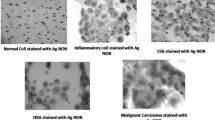Abstract
The significance of nucleolar organizer regions (NORs) and nuclear DNA content in 73 glottic carcinomas was assessed for proliferative activity and tumor progression. NORs stained with silver colloid were counted, and nuclear DNA content was assayed by cytofluorometry. The cytofluorometric study demonstrated that the percentage of tumors with aneuploidy tended to increase as histological differentiation decreased. Survival rates of patients with diploid and aneuploid tumors were not significantly different. AgNOR staining revealed that mean AgNOR numbers rose as histological differentiation of tumors decreased. Moreover, as T and N categories and stages showed advancing malignancy, mean AgNOR numbers tended to rise. However, there was no significant difference in survival rates between tumors with low and with high AgNOR counts. These studies indicate that while AgNOR staining is better than DNA cytofluorometry for determining histological differentiation of glottic carcinoma, neither is of prognostic value at the present time.
Similar content being viewed by others
References
shihara T, Kamachi M, Urata Y, Kusuzaki K, Takeshita H, Kagawa K (1986) Multiparametric analysis using autostage cytofluorometry. Acta Histochem Cytochem 19:51–59
Bockmühl U, Theissig F, Dimmer V, Kunze KD (1991) The impact of nucleolar organizer regions for the lymph node spread and prognosis of invasive ductal mammary carcinoma. Pathol Res Pract 187:437–443
Bryan RL, Allcock RA, Crocker J, Shenoi PM (1989) Nucleolar organizer regions in squamous tumours of the pharynx and larynx. J Clin Pathol 42:218
Crocker J, Skilbeck N (1987) Nucleolar organizer region associated proteins in melanotic lesions of the skin. J Clin Pathol 40:885–889
Crocker J, Macartney JC, Smith PJ (1988) Correlation between DNA flow cytometric and nucleolar organizer region data in non-Hodgkin's lymphomas. J Pathol 154:151–156
Das BC, Rani R, Mitra AB, Luthra UK (1986) The number of silver-staining NORs (rDNA) in lymphocytes of newborns and its relationship to human development. Mech Ageing Dev 36:117–123
Derenzini M, Romagnoli T, Mingazzini P, Marinozzi V (1988) Interphasic nucleolar organizer region distribution as a diagnostic parameter to differentiate benign from malignant epithelial tumors of human intestine. Virchows Arch [B] 54:334–340
Feinmesser P, Freeman J, Noyek A (1990) Flow cytometric analysis of DNA content in laryngeal cancer. J Laryngol Otol 104:485–487
Gillen P, Grace P, Dervan P, McDermott M, Smith J, Fitzpatrick JK (1988) Nucleolar organizer regions predict metastases in prostatic cancer. Br J Surg 75:1263
Goldsmith MN, Cresson DH, Postma DS, Askin FB, Pillsbury HD (1986) Significance of ploidy in laryngeal cancer. Am J Surg 152:397–402
Hamada S, Namura K, Fujita S, Hattori T (1990) DNA ploidy and proliferative activity of human pulmonary epithelium. Virchows Arch [B] 58:405–410
Holm LE (1982) Cellular DNA amounts of squamous cell carcinomas of the head and neck region in relation to prognosis. Laryngoscope 92:1064–1069
Howell WM, Black DA (1980) Controlled silver staining of nucleolus organizer regions with protective colloid developer: a one-step method. Experientia 36:1014–1015
International Union Against Cancer (UICC) (1987) Hermanek P, Sobin LH (eds) TNM classification of malignant tumours, 4th edn. Springer, Berlin Heidelberg New York
Miyahara H, Minami Y, Ueda K, Kanata H, Tsuruta Y, Matsunaga T (1993) The prognostic significance of nuclear DNA content and oncogene amplification in head and neck cancer (in Japanese). Head Neck Cancer 19:52–58
Moran K, Cooke T, Forster G, Gillen P, Sheehan S, Dervan P, Fitzpatrick JM (1990) Prognostic value of nucleolar organizer regions and ploidy values in advanced colorectal cancer. Br J Surg 76:1152–1155
Orita T, Kajiwara K, Nishizaki T, Ikeda N, Kamiryo T, Aoki H (1990) Nucleolar organizer regions in meningioma. Neurosurgery 26:43–46
Papadimitiou CS, Athanasiadou S, Stylianidou A, Karameris A (1991)Nucleolar organizer regions in the normal, hyperplastic and carcinomatous epithelium of endometrium. Virchows Arch [B] 60:155–160
Ploton D, Menager M, Jeannesson P, Himber G, Pigeeon F, Adnet JJ (1986) Improvement in the staining and visualization of the argyrophilic proteins of the nucleolar organizer region at the optical level. Histochem J. 18:5–14
Rüschoff J, Neumann K, Contractor H, Plate K, Thomas C (1990) Assessment of nucleolar organizer regions by automatic analysis in breast cancer: correlation with DNA content, proliferation rate, receptor status and histopathological grading. J Cancer Res Clin Oncol 116:480–485
Rüschoff J, Bittinger A, Neumann K, Schmitz-Moormann P (1990) Prognostic significance of nucleolar organizing regions (NORs) in carcinomas of the sigmoid colon and rectum. Pathol Res Pract 186:85–91
Sano K, Takahashi H, Fujita S, Inokuchi T, Pe MB, Okabe H, Tsuda N (1991) Prognostic implication of silver-binding nucleolar organizer regions (AgNORs) in oral squamous cell carcinoma. J Oral Pathol Med 20:53–56
Suzuki H, Kimura O, Nishihira T, Fujita S, Ashihara T, Fukuda M, Kaihara N, Shindo K, Taguchi T, Korenage D, Matsumoto K, Hamada S, Urata Y, Mikata K, Okajima K (1991) Report from the convention on nomenclature for DNA cytometry of the Japanese research society for DNA content. Jpn J Cancer Clin 37:1–3
Tanaka T, Takeuchi T, Nishikawa A, Takami T, Mori H (1989) Nucleolar organizer regions in hepatocarcinogenesis induced by N-2-fluorenylacetamide in rats: comparison with bromodeoxyuridine immunohistochemistry. Jpn J Cancer Res 80:1047–1051
Treré D, Farabegoli F, Cancellieri A, Ceccarelli C, Eusebi V, Derenzini M (1991) AgNOR area in interphase nuclei of human tumours correlates with the proliferative activity evaluated by bromodeoxyuridine labelling and Ki-67 immunostaining. J Pathol 165:53–59
Walter MA, Peters GE, Peiper SC (1991) Predicting radioresistance in early glottic squamous cell carcinoma by DNA content. Ann Otol Rhinol Laryngol 100:523–526
Yamamoto Y, Itoh T, Takahashi H (1994) Nucleolar organizer regions in tongue carcinomas induced in rats: comparison with DNA cytofluorometric analysis. Acta Otolaryngol (Stockh) 114:458–464
Yasuda N, Omori A, Goto T, Hisa Y, Murakami Y (1990) Prognostic significance of the DNA ploidy of the early glottic cancer (in Japanese). J Otolaryngol Jpn 93:1171–1178
Author information
Authors and Affiliations
Rights and permissions
About this article
Cite this article
Yamamoto, Y., Itoh, T., Saka, T. et al. Nucleolar organizer regions in glottic carcinomas: Comparison of DNA cytofluorometry and clinicopathological analysis. Eur Arch Otorhinolaryngol 252, 499–503 (1995). https://doi.org/10.1007/BF02114760
Received:
Accepted:
Issue Date:
DOI: https://doi.org/10.1007/BF02114760



